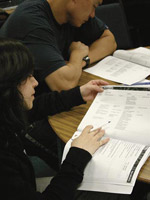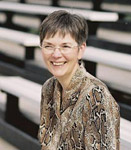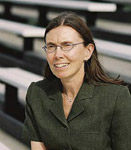
State of the Teaching Profession 2004
Confidence in public education on the rise
by Brian Jamieson
Celebrating Franco-Ontarian Youth
Report from the 11th Jeux Franco-Ontariens
by Gabrielle Barkany
Sharing Our Stories
Reflecting on teachers' mentoring experiences
by Brian Jamieson
Mapping the Journey to Student Success
Silver Springs PS aspires to seamless curriculum delivery
by Leanne Miller
Mapping the Journey to Student SuccessAt Silver Springs Public School, the learning team has turned its attention to building an integrated approach to curriculum.by Leanne Miller |
 |
Have you ever heard something like: "We did Native Canadians in Grade 4, why do we have to do it again in Grade 7?"
Have you ever asked: "This is Grade 6, why doesn't everyone know how to multiply two-digit numbers?"
Teachers at Silver Springs Public School in the Toronto District School Board are working towards the ideal of a seamless curriculum delivery that builds on previously taught skills and knowledge and eliminates gaps and needless repetition. To get there, they are mapping their curriculum.
As they develop their maps - which record the content, skills and assessments taught in all classes - Silver Springs teachers will build an accurate picture of what they actually teach during the year. This will be the basis for creating what is known as a seamless curriculum. As teachers share information with each other, it will allow them to identify and eliminate redundancies and gaps in topics and activities taught from one grade to the next. It will help them ensure that students are learning the curriculum's key knowledge and skills - the important concepts and big ideas.
Vice Principal Priscilla Yu has been instrumental in introducing mapping to Silver Springs. "Mapping is a means of tracking student progress and delivering a more coherent and seamless program. It will help teachers to better link assessments to the provincial expectations and to their related teaching and learning activities. It will allow us to articulate the essential questions that will focus our teaching and show students the purpose, progression and links in their learning."
The need for mapping
In her 1997 book, Mapping the Big Picture, Heidi Hayes Jacobs explains the need for mapping:
Though teachers may work together in the same building for years, they usually have sketchy knowledge about what goes on in each other's classrooms and most have no clue as to their colleagues' books, concepts and assignments ... If there are gaps among teachers within buildings, there are virtual Grand Canyons among buildings in a district ... None of us chooses to make the absence of effective communication a reality ... Teachers cannot run up and down the halls with notepads gathering information about curriculum and assessment. They cannot call every teacher each student has had for the past few years. Curriculum mapping amplifies the possibilities for long-range planning, short-term preparation and clear communication.
After hearing Jacobs speak at a 2003 conference, Yu realized that mapping would complement the work of her school's combined grade teams. At Silver Springs, teachers have the same group of students for two years and they had already identified many of the content expectations covered in their programs. Nine teachers formed a curriculum-mapping learning community, and with funding from their board, purchased Jacobs's mapping books and videos and began their mapping journey.
 |
"Mapping will help us cluster expectations, integrate where appropriate and articulate essential questions." Christine Pryde, Grades 7 and 8 teacher |
This June teachers were introduced to the concept of mapping and in the fall they begin mapping their school-wide social studies curriculum, focusing on clustering the content they have already mapped and then adding skills, assessments, resources and essential questions.
Yu estimates that it will take several years to map the school's entire curriculum, but says, "It doesn't matter how long it takes because mapping impacts all aspects of our teaching practice and we benefit from the process and the dialogue as much as from the completed maps."
Principal Sheldon Diamond says, "Social studies was a good place to start mapping because it encourages integration and embraces many important skills - including reading, writing and critical thinking."
Brad Parolin, who teaches Grades 7 and 8 at Silver Springs, says, "There are hundreds of expectations in Grade 7 and we can't possibly cover them all. Mapping allows us to focus our teaching and learning activities and our assessments to ensure that we address what's really important - the essential ideas - and aim for deep student understanding. When the curriculum is a mile wide, we can only get an inch deep and that's not how we want to teach.
 |
"After ten years of teaching . I'm still reinventing the wheel every time I begin a new unit. Mapping will make it easier for me to modify activities." Brad Parolin, Grades 7 and 8 teacher |
"Even after 10 years of teaching," says Parolin, "I'm still reinventing the wheel every time I begin a new unit. Mapping will make it easier for me to modify activities as I go along. Plus, I'll have easy access to what my colleagues are doing with their students, so I can build on their work rather than duplicating it. It will also be easier to use consistent language with our students."
Maria Brancato, a Grade 5-6 team leader, says, "I am constantly asking my students about their learning history - what they know and what skills they have. Mapping will give me this information and allow me to concentrate on teaching what students don't know, instead of finding out and reteaching what they should know."
"Science has a huge number of expectations," says Christine Pryde, who teaches Grades 7 and 8. "The temptation is to check them off as we cover them, but students don't get deep understanding because there is so much to cover. Mapping will help us cluster expectations, integrate where appropriate and articulate essential questions. This will focus our teaching and give students deeper learning experiences."
Special benefits
Louise Henderson is a special education resource teacher, a teacher librarian and a 33-year veteran. She believes that mapping will allow her to improve support to colleagues - helping her to find complementary resources. "I will be able to find the literature, biographies and other resources that will encourage integration and provide richer learning experiences. And if students want to read ahead, I will be able to direct them to appropriate resources simply by consulting their grade maps. The benefits are enormous."
All agree that mapping will help students with learning disabilities. Currently, identified students are withdrawn for up to half a day, missing work in their regular classrooms. Maps will improve communication, permitting teachers to work together to ensure that, where possible, students cover the same material. Sharing essential questions will help special education resource teachers cover the most important information and students will feel less stigmatized when they return to their regular classrooms because they will know what was taught and will be better able to participate in activities alongside their classmates. Mapping offers similar benefits to ESL teachers and students.
 |
"Maps will help me better support teachers with complementary resources . the benefits are enourmous." Louise Henderson, special education resource teacher and teacher librarian |
Teachers also see benefits for their assessment practices. Beth Kalisz, a Grade 1-2 team leader who has taught for 30 years, suggests, "We may find that we are using too many pencil and paper assessments with Grade 1 and 2 students and decide to leave these to the later grades and focus our assessments in other areas."
Yu expands on the benefits. "Our students write journals and book reports from Grade 1 right through to Grade 8. When we map these activities and how we assess them, we will ensure that our expectations and assessments appropriately increase in complexity and sophistication."
As more teachers approach retirement, mapping may hold the added benefit of allowing veteran teachers to leave the rich legacy of their experience to present and future students and colleagues - a legacy more accessible than the usual profusion of notes and files.
Mapping requires essential questions (EQs). Yu says, "EQs are the essence of what we believe our students can realistically learn in the amount of time we have with them. They become our focus for teaching and learning and allow us to do a better job of showing students where they have been and where they are going."
The teachers at Silver Springs attended a workshop this June on mapping and developing EQs, facilitated by Christine Shain - consultant and colleague of Heidi Hayes Jacobs. Shain has worked with Canadian and American schools interested in mapping for several years.
"We are just beginning to embrace mapping in Ontario because we have been busy implementing new curriculum over the past few years. Now teachers want to move beyond merely covering the expectations, and mapping helps us make decisions about clustering the myriad expectations and deciding how and what to teach. As well, it shows appropriate areas for meaningful integration and helps us ensure that we use a progression of increasingly sophisticated assessments."
 |
"I see mapping as a tool . that will allow us to identify the essential elements of our curricullum." Beth Kalisz, Grades 1-2 team leader |
Curriculum mapping is neither an easy nor a speedy process, and it must be embraced by an entire staff and strongly supported by administration.
"Some teachers may resist because they won't want to give up favourite activities. On the other hand, mapping will allow us to focus and better manage the vague but vast curriculum," says Kalisz. "I see mapping as a tool, not a new philosophy. It will allow us to identify the essential elements of our curriculum and teach for deep understanding, not just check off the expectations as we scramble to cover them all."
Maria Brancato has been teaching for seven years. "Mapping is a great idea but it's idealistic and overwhelming. It will take years to complete our school-wide map and it's vital that all teachers be committed to the process."
Making time
Shain admits that time is the biggest challenge of mapping, and in her workshops she encourages teachers to brainstorm strategies to manage time constraints before the mapping process begins. "We need time to enter data in the maps, time to share and interpret maps and time to make and implement curriculum decisions. Mapping cannot be another add-on; it must be a school priority."
Diamond agrees. "We've had outstanding support from our superintendent and the board in funding and release time for teachers. Support from school administration may be seen with flexible and creative time-tabling and budgeting to support PD."
Yu adds, "We are just at the infancy stage, but mapping will be a priority for the next few years. To do it well will take thought, preparation, planning and a great deal of time, and we're taking small steps and making sure we do it right."
Longer term, teachers hope to post maps in classrooms - sharing them with students and parents. They envision a seamless Kindergarten to Grade 12 curriculum with increased communication between the elementary and secondary panels. As Diamond says, "We are starting small but thinking big."
With the thought and effort that has already gone into the curriculum mapping journey at Silver Springs, it seems more like they have started big and are thinking even bigger.
 |
|
Back Row (from left): Dave Tenn, Paula Browne, Brad Parolin, Sheldon Diamond Front Row (from
left): Angela Tsokanaridis, Karuna Sato, Susan Lai, Priscilla
Yu, Louise Henderson, Christine Pryde |
Heidi Hayes Jacobs's Seven-Step Curriculum Mapping Process
1. Data collection
All teachers in a building individually map the content, skills and assessments they teach. While detailed information about daily lesson plans isn't needed, specific skills and assessments are required. Essential questions and resources may also be included. The format and language must be consistent for all maps, but maps should also reflect the individual nature of classrooms.
2. First read-through
Working as an editor, each teacher reads the entire school map, highlighting places where new information was gained, areas for potential integration and areas requiring potential revision, such as repetition. Expect to hear, "I didn't know you taught that!" Teachers should work alone for the first read-through. If a group of teachers starts out together they may try to avoid offending someone and overlook problems.*
3. Small-mixed-group review
Groups of five to eight staff from diverse grade levels and departments review maps, sharing individual findings, not revising or judging. Teachers should identify areas where they learned something, areas where they spotted gaps or repetitions, potential areas for integration, mismatches between expectations and curriculum, and meaningful and non-meaningful assessments. Reviewers highlight areas that require attention but do not rewrite curriculum.*
4. Large-group comparisons
Facilitated by the principal or a school leader, the entire staff examines the findings from the smaller groups. Staff must decide whether the whole group will work together or break into smaller units because now is the time to begin editing, revising and developing new curriculum. If a staff is smaller than 25 it is appropriate to remain as one group. If larger, then working in grade, division or subject-area teams may be more appropriate.*
5. Complete immediate revisions
Identify repetitions or gaps that can be remedied quickly, determining who will make revisions and when.
6. Determine areas requiring research and planning
While reviewing maps, teachers will find areas that require in-depth investigation or thought before they can revise curriculum. For example, there might be a gap in writing expectations between junior and intermediate grades that will require reviewing expectations, assessments and teaching and learning activities across several grades.
7. Ongoing updating of maps
Because curriculum mapping is an ongoing process, teachers must continually review and update maps.
* Ontario educational consultant Christine Shain suggests that schools consider different groupings for sharing and interpreting maps, based on their mapping purposes.
Consultant Christine Shain offers these suggestions when developing maps:
- Create a map template (using tables in Word, for example) or choose a software program that suits your school's mapping purposes.
- Identify the big ideas and main concepts.
- Use descriptive, precise and concise language to articulate clearly. what is being taught and assessed.
- Give sufficient detail but not lesson plans.
- Align knowledge and skills with assessments and expectations.
- Be specific about skills taught versus skills practised and extended.
- Use essential questions that are embedded in the curriculum and revisited throughout a unit; use student language and have more than one correct answer to engage students throughout the learning process.
Resources
![]() Heidi Hayes Jacobs, Mapping
the Big Picture: Integrating Curriculum and Assessment K-12. Alexandria, Virginia: Association for Supervision
and Curriculum Development (ASCD), 1997.
Heidi Hayes Jacobs, Mapping
the Big Picture: Integrating Curriculum and Assessment K-12. Alexandria, Virginia: Association for Supervision
and Curriculum Development (ASCD), 1997.
![]() Video
1: Curriculum Mapping - Charting the Course for Content: The
Essentials of Mapping. Alexandria, Virginia: ASCD, 1999.
Video
1: Curriculum Mapping - Charting the Course for Content: The
Essentials of Mapping. Alexandria, Virginia: ASCD, 1999.
![]() Video
2: Curriculum Mapping - Charting the Course for Content: Putting
Mapping to Work. Alexandria, Virginia: ASCD, 1999.
Video
2: Curriculum Mapping - Charting the Course for Content: Putting
Mapping to Work. Alexandria, Virginia: ASCD, 1999.
![]() Curriculum
Mapping - Facilitator's Guide. Alexandria, Virginia: ASCD,
1999.
Curriculum
Mapping - Facilitator's Guide. Alexandria, Virginia: ASCD,
1999.
![]() An Interview with Dr. Heidi Hayes Jacobs in New
Needs, New Curriculum in Educational Leadership, Volume 61, Number 4, pages 12-17. Alexandria,
Virginia: ASCD, December 2003 / January 2004.
An Interview with Dr. Heidi Hayes Jacobs in New
Needs, New Curriculum in Educational Leadership, Volume 61, Number 4, pages 12-17. Alexandria,
Virginia: ASCD, December 2003 / January 2004.
![]() Grant Wiggins and Jay McTighe, Understanding
by Design. New York:
Pearson Education, 2000.
Grant Wiggins and Jay McTighe, Understanding
by Design. New York:
Pearson Education, 2000.
![]() Lynn H. Erikson, Stirring
the Head, Heart, and Soul: Redefining Curriculum and Instruction. Thousand Oaks, California: Corwin Press, 2000.
Lynn H. Erikson, Stirring
the Head, Heart, and Soul: Redefining Curriculum and Instruction. Thousand Oaks, California: Corwin Press, 2000.
Related web sites
![]() Curriculum
Mapping or Backward Design (May 18, 2000), a power-point presentation
by Ainsley B. Rose, Director of Education at Western Quebec School Board,
is available at
www.qesnrecit.qc.ca/reform/pd/docs/WQSB/curriculum_mapping.ppt.
Curriculum
Mapping or Backward Design (May 18, 2000), a power-point presentation
by Ainsley B. Rose, Director of Education at Western Quebec School Board,
is available at
www.qesnrecit.qc.ca/reform/pd/docs/WQSB/curriculum_mapping.ppt.
![]() Teachers
of Palliser regional schools in Alberta began to use curriculum mapping
in 2000 as an aid to improving student learning. Their web site at www.pallisersd.ab.ca/sites/aisi/curricmapping.htm
includes a resources page with information on the mapping process and
essential questions.
Teachers
of Palliser regional schools in Alberta began to use curriculum mapping
in 2000 as an aid to improving student learning. Their web site at www.pallisersd.ab.ca/sites/aisi/curricmapping.htm
includes a resources page with information on the mapping process and
essential questions.
![]() The
University of Windsor offers examples of existing faculty/librarian collaborations
in programmatic curriculum design on their curriculum-maps page at athena.uwindsor.ca/units/leddy/2002.nsf/HelpInstructionMaps?OpenForm.
The
University of Windsor offers examples of existing faculty/librarian collaborations
in programmatic curriculum design on their curriculum-maps page at athena.uwindsor.ca/units/leddy/2002.nsf/HelpInstructionMaps?OpenForm.
![]() Heidi
Hayes Jacobs's web site is at www.curriculumdesigners.com.
Heidi
Hayes Jacobs's web site is at www.curriculumdesigners.com.
![]() You
can contact workshop leader Christine Shain at christine_shain@havergal.on.ca.
You
can contact workshop leader Christine Shain at christine_shain@havergal.on.ca.




